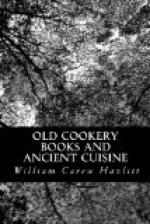A story is told here of Cromwell and his wife sitting down to a loin of veal, and his calling for an orange, which was the sauce he preferred to that joint, and her highness telling him that he could not have one, for they were not to be had under a groat.
The Mansion House still retains the ancient usage of distributing the relics of a great feast afterwards among the poor, as Cromwell is said just above to have made a rule of his household. It was a practice highly essential in the absence of any organised system of relief.
The reign of Charles II., which witnessed a relationship with France of a very different character from that which the English maintained during the Plantagenet and earlier Tudor rule, was favourable to the naturalisation of the Parisian school of cookery, and numerous works were published at and about that time, in which the development of knowledge in this direction is shown to have taken place pari passu with the advance in gardening and arboriculture under the auspices of Evelyn.
In 1683 we come to a little volume entitled “The Young Cook’s Monitor,” by M.H., who made it public for the benefit of his (or her) scholars; a really valuable and comprehensive manual, wherein, without any attempt at arrangement, there is an ample assemblage of directions for preparing for the table all kinds of joints, made dishes, soups and broths, frigacies, puddings, pies, tarts, tansies, and jellies. Receipts for pickling are included, and two ways are shown how we should treat turnips after this wise. Some of the ingredients proposed for sauces seem to our ears rather prodigious. In one place a contemporary peruser has inserted an ironical calculation in MS. to the effect that, whereas a cod’s head could be bought for fourpence, the condiments recommended for it were not to be had for less than nine shillings. The book teaches us to make Scotch collops, to pickle lemons and quinces, to make French bread, to collar beef, pork, or eels, to make gooseberry fool, to dry beef after the Dutch fashion, to make sack posset two ways, to candy flowers (violets, roses, etc.) for salads, to pickle walnuts like mangoes, to make flummery, to make a carp pie, to pickle French beans and cucumbers, to make damson and quince wines, to make a French pudding (called a Pomeroy pudding), to make a leg of pork like a Westphalia ham, to make mutton as beef, and to pot beef to eat like venison.
These and many other precepts has M.H. left behind him; and a sort of companion volume, printed a little before, goes mainly over the same ground, to wit, “Rare and Excellent Receipts Experienced and Taught by Mrs. Mary Tillinghast, and now printed for the use of her scholars only,” 1678. The lady appealed to a limited constituency, like M.H.; but her pages, such as they are (for there are but thirty), are now publici juris. The lesson to be drawn from Mistress Tillinghast’s printed labours is that, among our ancestors in 1678, pies




